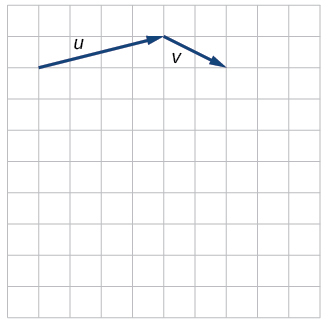10.8E: Vectors (Exercises)
- Page ID
- 56122
For the following exercises, determine whether the two vectors, \(\mathbf{u}\) and \(\mathbf{v},\) are equal, where \(\mathbf{u}\) has an initial point \(P_{1}\) and a terminal point \(P_{2},\) and \(\mathbf{v}\) has an initial point \(P_{3}\) and a terminal point \(P_{4}\).
52. \(P_{1}=(-1,4), P_{2}=(3,1), P_{3}=(5,5)\) and \(P_{4}=(9,2)\)
53. \(P_{1}=(6,11), P_{2}=(-2,8), P_{3}=(0,-1)\) and \(P_{4}=(-8,2)\)
For the following exercises, use the vectors \(\mathbf{u}=2 \mathbf{i}-\mathbf{j}, \mathbf{v}=4 \mathbf{i}-3 \mathbf{j},\) and \(w=-2 \mathbf{i}+5 \mathbf{j}\) to evaluate the expression.
54. \(u-v\)
55. \(2 v-u+w\)
For the following exercises, find a unit vector in the same direction as the given vector.
56. \(a=8 i-6 j\)
57. \(b=-3 i-j\)
For the following exercises, find the magnitude and direction of the vector.
58. \(\langle 6,-2\rangle\)
59. \(\langle-3,-3\rangle\)
For the following exercises, calculate \(\mathbf{u} \cdot \mathbf{v}\).
60. \(u=-2 i+j\) and \(v=3 i+7 j\)
61. \(u=i+4 j\) and \(v=4 i+3 j\)
62. Given \(\boldsymbol{v}=\langle-3,4\rangle\) draw \(\boldsymbol{v}, 2 \boldsymbol{v},\) and \(\frac{1}{2} \boldsymbol{v}\)
63. Given the vectors shown in Figure 4 , sketch \(\boldsymbol{u}+\boldsymbol{v}, \boldsymbol{u}-\boldsymbol{v}\) and \(3 \boldsymbol{v}\).

Figure 4
64. Given initial point \(P_{1}=(3,2)\) and terminal point \(P_{2}=(-5,-1),\) write the vector \(\mathbf{v}\) in terms of \(\mathbf{i}\) and \(\mathbf{j}\). Draw the points and the vector on the graph.


